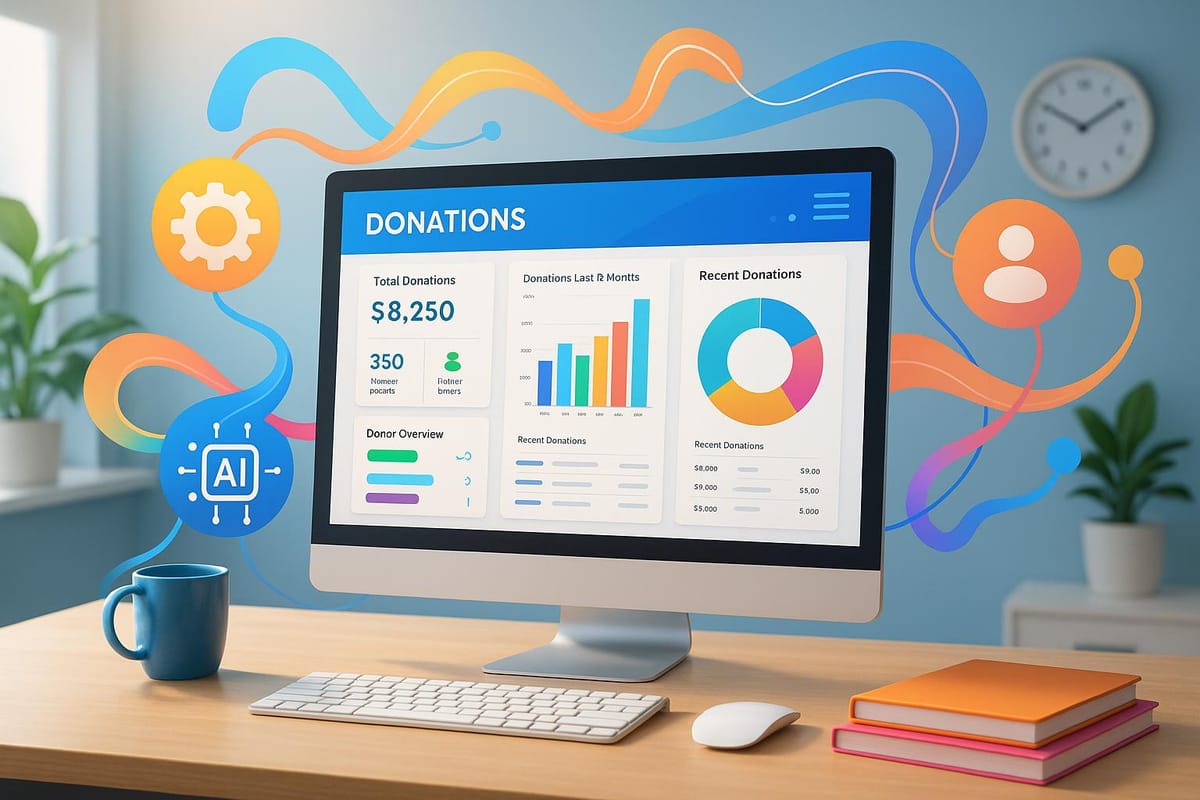How to Automate Donor-Focused Nonprofit Marketing
Learn 4 simple steps to automate donor-focused marketing for nonprofits. Save time, boost engagement, and increase donations with AI and workflows.

In the competitive world of nonprofit fundraising, especially for child sponsorship programs, standing out and securing consistent donor support can be overwhelming. Nonprofits often operate with limited resources, yet they must balance donor engagement, retention strategies, and communication - all while staying true to their mission. This guide will take you through a transformative approach to donor-focused nonprofit marketing, based on insights shared by marketing expert Cynthia Prito. You'll discover how to segment your audience, tailor your messaging, and implement automation systems to save time while driving meaningful results.
By the end of this guide, you'll have actionable steps to create a streamlined, efficient marketing system that engages donors, builds loyalty, and maximizes contributions.
Why Generic Marketing Doesn’t Work
Let’s start with a reality check: attempting to market to everyone means your nonprofit is likely losing potential donations, alienating supporters, and experiencing high unsubscribes. A one-size-fits-all message, such as "Help us hit our goal", lacks relevance and fails to resonate with the diverse motivations of your donors.
Instead, Cynthia Prito emphasizes the importance of breaking down your audience into targeted segments and aligning your messaging with their unique motivations. This personalized approach ensures that messages capture attention, foster connection, and ultimately result in sustained support.
Step 1: Define and Segment Your Audience
Audience segmentation is the cornerstone of donor-focused marketing. Simply categorizing supporters as donors, volunteers, or community partners isn’t enough - you need to go deeper. Here’s how to effectively segment your audience:
Key Segments to Consider
- First-time donors: These individuals require tailored communication to encourage repeat giving. Share stories about the immediate impact of their first contribution and how it supports your mission.
- Consistent donors: Regular contributors who give monthly or quarterly need ongoing updates about their sustained impact. This helps maintain their engagement and inspires them to continue giving.
- Major donors: High-contribution donors require a more personalized approach that reflects their unique relationship with your nonprofit. This may include direct updates, personal thank-yous, or invitations to exclusive events.
- Volunteers: Volunteers donate their time, a critical asset. Keep them informed about successes and demonstrate how their efforts make a difference.
- Community advocates and partners: These individuals or organizations spread awareness and influence others to engage with your nonprofit. Equip them with success stories and outcomes they can share.
Why Segmentation Matters
Each donor or supporter group has different motivations and expectations. For example, first-time donors may need reassurance about how their funds are utilized, while volunteers may feel more connected through stories of the lives they’ve helped change. The better you understand these differences, the more relevant your messaging will be.
Step 2: Align Your Message with Motivation
Even with segmentation in place, crafting the right message is crucial. A generic fundraising appeal will likely fall flat, but a message that speaks directly to each segment’s motivations will stand out. Cynthia suggests asking a critical question: What initially inspired this donor to give?
Tailor Your Messaging to Each Group
- Volunteers: Highlight impact stories and wins - e.g., the number of children helped or families served. These updates validate their contributions and deepen their commitment.
- Donors: Share measurable outcomes tied to their contributions, such as quarterly or annual impact reports. For instance, "Your $50 helped provide meals for 20 children last month."
- Community Partners: Provide specific examples of how their collaboration enables broader success, such as expanding access to education or healthcare.
Remember, it’s not just about showing results - it’s about reinforcing the emotional connection that initially motivated them to support your cause.
Step 3: Think Outside the Box in Tailoring Messages
Tailoring your message sometimes requires creative problem-solving and honest conversations. Cynthia shares the example of a STEM-focused nonprofit that struggled to gain support from engineering firms. By engaging in candid discussions, they discovered the key was aligning with political leaders who could vouch for their programs. This unusual yet effective approach highlights the importance of understanding donors’ priorities, even if they differ from your own.
How to Think Creatively
- Explore partnerships with influential advocates or leaders in your community.
- Ask potential donors for advice before requesting contributions - this builds trust and rapport.
- View your messaging from the donor’s perspective: What do they care about most right now?
Step 4: Automate to Save Time and Scale Effectively
For many nonprofits, the idea of creating tailored messaging for multiple segments can feel daunting, especially with limited staff and resources. However, automation is a game-changer. While setting up automation workflows requires an upfront investment of time, once completed, these systems run efficiently in the background.
Essential Tools for Automation
- Email marketing platforms (e.g., Mailchimp or MailerLite): Use workflows to automatically sort donors into categories like first-time, recurring, or major donors. Pre-schedule email campaigns tailored to each group.
- AI writing tools: Tools like ChatGPT can help generate personalized content quickly. Be sure to use precise prompts for the best results.
- Canva: This design tool simplifies the creation of branded marketing materials, including flyers, emails, and social media posts. Customize templates to maintain consistent branding.
- Google Sheets: Google’s free tools, including AI-enhanced Sheets, can streamline data tracking and analysis, such as monitoring new donors or segment performance.
Pro Tip
Consider hiring a freelancer or specialist if your team lacks expertise in email marketing or automation. They can set up workflows efficiently, saving your team hours of manual work.
Key Takeaways
- Audience segmentation is essential: Break your audience into meaningful categories like first-time donors, recurring donors, and volunteers.
- Personalized messaging drives engagement: Tailor your communication to the unique motivations of each group.
- Think creatively when pitching: Understand that donors may have different priorities than your organization’s mission - meet them where they are.
- Automation saves time: Use email workflows, AI tools, and design platforms to streamline communication processes.
- Data is your ally: Track donor behavior and adjust your strategies based on measurable outcomes.
Conclusion
Creating a sustainable donor-focused marketing strategy requires effort, but the rewards are invaluable. By segmenting your audience, aligning your messaging with their motivations, and leveraging automation tools, your nonprofit can build stronger connections, increase donor retention, and make a lasting impact. Start small, focus on one or two segments initially, and scale as you refine your workflows.
With these strategies in place, your child sponsorship program can turn one-time donors into lifelong supporters - empowering your mission to create meaningful change in the lives of children and their communities.
Source: "4 Easy Nonprofit Marketing Tricks to Boost Results While You Sleep" - Joanne Toller - Fundraising Coach, YouTube, Sep 29, 2025 - https://www.youtube.com/watch?v=P90-qmpMbkQ

